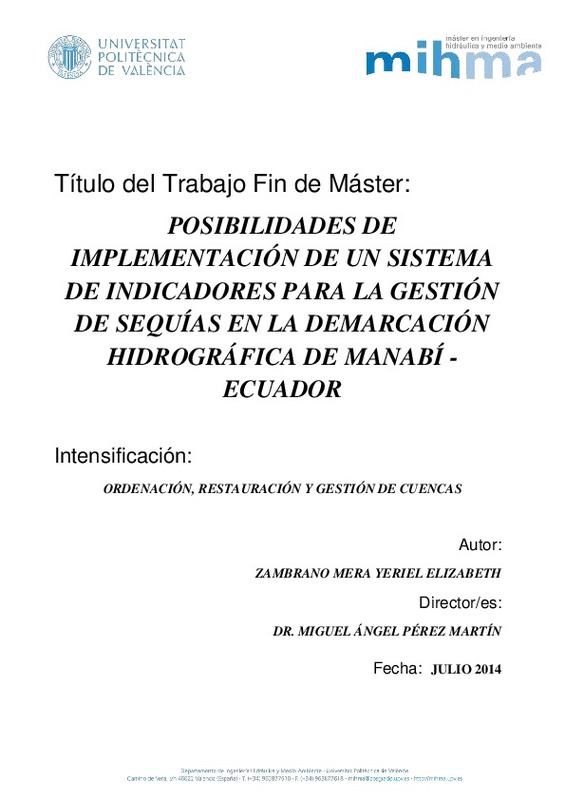JavaScript is disabled for your browser. Some features of this site may not work without it.
Buscar en RiuNet
Listar
Mi cuenta
Estadísticas
Ayuda RiuNet
Admin. UPV
Posibilidades de implementación un sistema de indicadores para la gestión de la sequía en la Demarcación Hidrográfica de Manabí - Ecuador
Mostrar el registro sencillo del ítem
Ficheros en el ítem
| dc.contributor.advisor | Pérez Martín, Miguel Ángel
|
es_ES |
| dc.contributor.author | ZAMBRANO MERA, YERIEL
|
es_ES |
| dc.date.accessioned | 2016-01-13T10:44:24Z | |
| dc.date.available | 2016-01-13T10:44:24Z | |
| dc.date.created | 2014-07-23 | |
| dc.date.issued | 2016-01-13 | |
| dc.identifier.uri | http://hdl.handle.net/10251/59791 | |
| dc.description.abstract | [EN] In Ecuador, Manabi is one of the provinces most affected by droughts. The UN confirms this fact, and also considers it as one of the provinces most affected by desertification. Furthermore, on the basis of the intensity of water scarcity, it was established that this is an area potentially at risk of such an event. The need to predict droughts is essential to avoid serious consequences. In this respect, drought managers have a series of tools (e.g. drought indices) to constantly monitor event conditions and anticipate these occurences. Three drought indices have been selected in this study: the Standardized Precipitation Index, SPI; the Palmer Drought Severity Index, PDSI; and the Index of State, I.e., developed by McKee et al. 1983, Palmer 1965 and CHJ 2000, respectively. These indices were applied at the level of the river basin district of Manabi, which was divided into three zones: North Zone, Central Zone and South Zone. The analysis of the indices encompassed the period between 1964 - 2012 (48 years). The results obtained from the application of the SPI were validated with the written records from the local press addressing the issue of droughts in the study area,.This allowed us to establish the relationship between the calculated and the observed values. The SPI exposed the drought events occurred in the district. Similarly, I.e. index shows that the volumes of the reservoirs do not reach their minimum levels. Finally, the results of the Standardized Precipitation Index were compared with the results of the climate indices; Southern Oscillation Index, SOI; and Sea Surface Temperature, SST; to determine the influence of El Niño - Southern Oscillation, ENSO climatic events; with the manifestation of drought at the level of the river basin district of Manabi, and was established the climate index SST as a good indicator of drought in the district. | es_ES |
| dc.description.abstract | [ES] En Ecuador, Manabí es una de las provincias más afectadas por las sequías. Las Naciones Unidas ratifica este hecho, y también la considera como una de las provincias más afectadas por la desertificación. Además basándose en la intensidad del déficit hídrico se estableció que es una zona potencialmente expuesta al evento. La necesidad de prever las sequías es fundamental para evitar que produzcan graves consecuencias. Para esto los gestores utilizan herramientas que permiten monitorear constantemente las condiciones del evento y anticiparse al mismo, como son los índices de sequía. En el presente estudio, se han seleccionado tres índices de sequía: el Standardized Precipitation Index, SPI; el Palmer Drought Severity Index, PDSI; y el índice de Estado, I.e.; desarrollado por McKee et al. 1983, Palmer 1965 y CHJ 2000, respectivamente. Estos índices fueron aplicados en la Demarcación hidrográfica de Manabí, misma que fue divida en tres zonas: Zona Norte, Zona Centro y Zona Sur. El análisis de los índices se rigío al periodo 1964 - 2012 (48 años). Los resultados obtenidos de la aplicación del SPI fueron validados con los registros de prensa que abordan el tema de sequía en la zona de estudio, lo cual permitió establecer la relación entre lo calculado y lo observado. El SPI, reflejó los eventos de sequía acontecidos en la demarcación. En cuanto al I.e., este muestra que los volúmnes de los embalses no alcanzan su nivel mínimo. Finalmente se contrastaron los resultados del Índice de Precipitación Estandarizada con los resultados de los índices climáticos; Southern Oscillation Index, SOI; y Sea Surface Temperature, SST; para determinar la influencia de los eventos climáticos El Niño - Southern Oscillation, ENSO; con la manifestación de la sequía en la Demarcación Hidrográfica de Manabí, se estableció el índice climático SST como un buen indicador de las sequías en la demarcación. | es_ES |
| dc.format.extent | 98 | es_ES |
| dc.language | Español | es_ES |
| dc.publisher | Universitat Politècnica de València | es_ES |
| dc.rights | Reserva de todos los derechos | es_ES |
| dc.subject | Sequía | es_ES |
| dc.subject | Índices de sequía | es_ES |
| dc.subject | Eventos climáticos ENOS | es_ES |
| dc.subject | Droguht | es_ES |
| dc.subject | Drought Index | es_ES |
| dc.subject | Climate events ENSO | es_ES |
| dc.subject.classification | INGENIERIA HIDRAULICA | es_ES |
| dc.subject.other | Máster Universitario en Ingeniería Hidráulica y Medio Ambiente-Màster Universitari en Enginyeria Hidràulica i Medi Ambient | es_ES |
| dc.title | Posibilidades de implementación un sistema de indicadores para la gestión de la sequía en la Demarcación Hidrográfica de Manabí - Ecuador | es_ES |
| dc.type | Tesis de máster | es_ES |
| dc.rights.accessRights | Abierto | es_ES |
| dc.contributor.affiliation | Universitat Politècnica de València. Servicio de Alumnado - Servei d'Alumnat | es_ES |
| dc.description.bibliographicCitation | Zambrano Mera, Y. (2014). Posibilidades de implementación un sistema de indicadores para la gestión de la sequía en la Demarcación Hidrográfica de Manabí - Ecuador. http://hdl.handle.net/10251/59791 | es_ES |
| dc.description.accrualMethod | Archivo delegado | es_ES |






